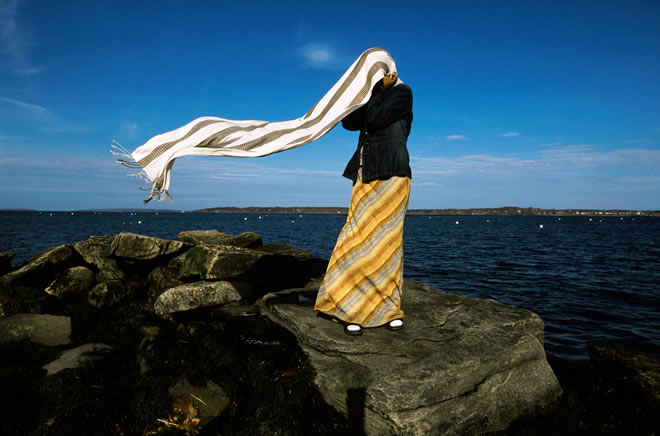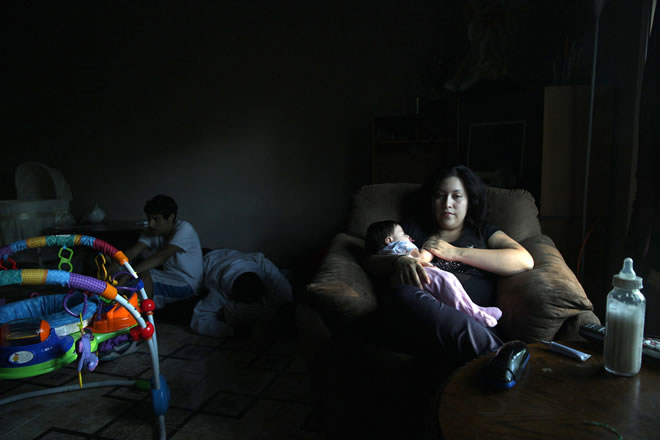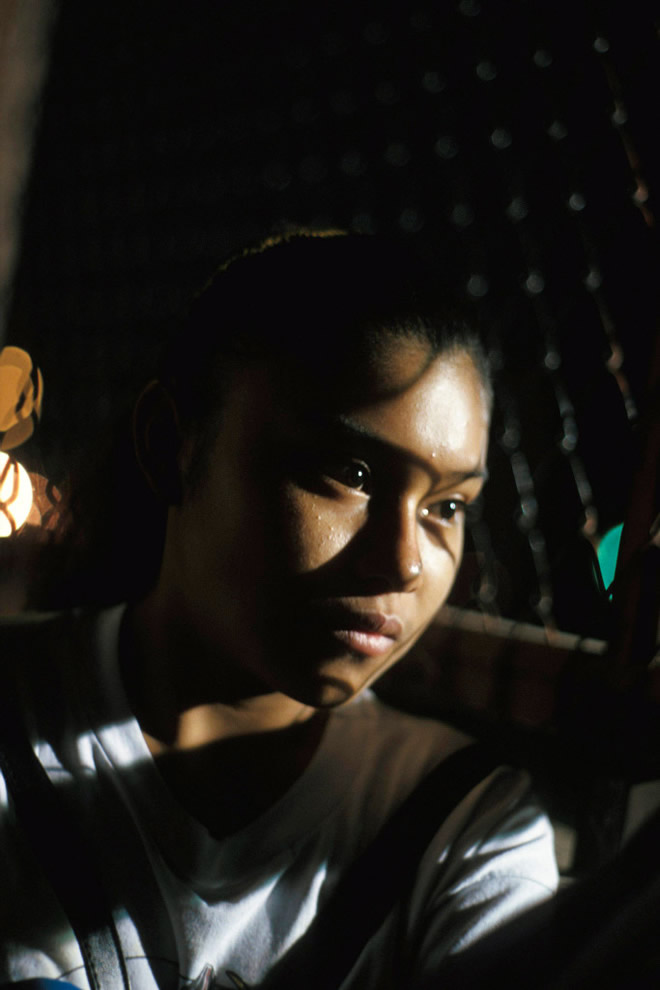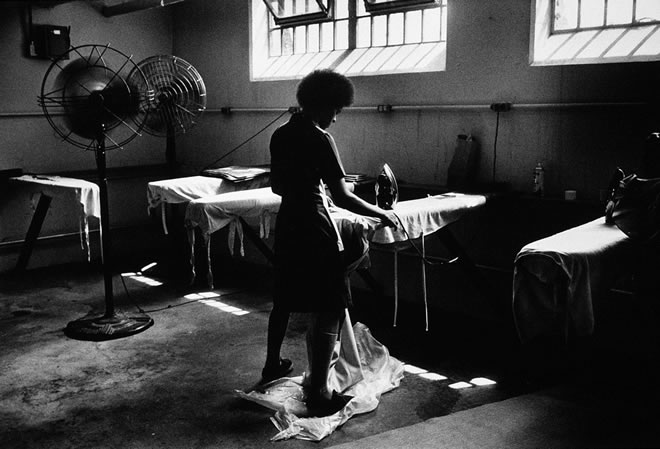

Sunday, March 08, 2015
What do photographs of women, taken by women, look like? In honor of International Women’s Day, March 8, I asked seven female National Geographic photographers to share an image they took that revealed a woman’s experience. In a world where gender equality is still elusive, these photographs tell stories of hope, bravery, hardship, and survival. I want to give my thanks to the incredible photographers for their vision and dedication to sharing stories of women’s experiences worldwide.

Philomene, Haiti, 1988 Photograph by Maggie Steber
Philomene was a schoolgirl in a small town called Beauchamps in the barren northwest of Haiti, where nothing grows except short mesquite trees. It is one of the largest charcoal-producing areas, and the overwhelming deforestation creates an impoverished landscape that beats people down. I photographed Philomene in 1988. By now she is a grown woman. In this photograph of her I see the great spirit and strength of the Haitian people. In Philomene’s face shines the pride in her country’s singular history as the first black republic in the world born of a successful slave revolt. She loved school and had determination to learn. I loved her dress, the tuft of her hair, and an air of possibility that surrounded her.
Haitian women are the ones who make Haiti run. They are the glue of this tiny nation, whether they are market women selling vegetables, charcoal, and used clothing, or middle-class and wealthier women running their own businesses or working as teachers or politicians. When a market woman walks down the street with a big basket or bucket of water balanced on her head, she walks like a queen. I saw this same thing in Philomene, a queen in the making.
The hope of Haiti’s future is in children. A hardscrabble life either crushes them or makes them stronger, and in this case, it made Philomene stronger. She held her head up high, even if she was poor. At least she could read, write, and add numbers. When I show my work on Haiti, I always end with Philomene because in her face is represented all the hope and dreams of a nation. And of women everywhere.

Safeya Sayed Shedeed, 2012 Photograph by Laura El-Tantawy
Somewhere between fear and sorrow there are often tears. I have seen pools of them. Normally I put my camera down. It feels like I am imposing on a deeply private and intimate moment. Safeya Sayed Shedeed is an Egyptian mother whose son was killed by police on January 28, 2011, a day locals dubbed the “Friday of Rage.” It was three days after the start of the protests that eventually unseated former strongman Hosni Mubarak. Safeya was sitting against the summer’s scorching asphalt, dressed in black from head to toe, as is customary in Egypt when one is in mourning. Sometimes the black is never replaced by another color, a sign the heart is still in deep sorrow even though the soul is trying to recover. “I want to avenge my son,” she told me. “Who will get my son’s rights back?” Safeya was among a group of women who lost loved ones during the violent protests.
Photographing the turmoil in Egypt was a profound experience for me as an Egyptian. I saw grown men weep like children and elderly women scream at the top of their lungs like warriors. I also met women like Safeya whose tears have seeped deep into the ground. I go back to this photograph often. I wonder about her expression, which always struck me as somewhere between peace and sadness. I ask myself how she can muster the strength. I met other mothers whose sons were killed in the revolution. One of them told me she often goes out on the street looking for her son among his friends. Another told me she catches herself having conversations with her son while she’s in the kitchen cooking or sitting in the living room. I wonder if Safeya goes through this too. Does she still wear black? I wonder how the future of Egypt will look back at hundreds, if not thousands, of people like Safeya whose lives changed forever in the course of the struggle to achieve dignity and respect for all.

Cynthia (22) and Vivian (4 months) at home, October 19, 2013 Photograph by Kitra Cahana
I met Cynthia Santana and her four-month-old baby, Vivian, on a cold morning in the Houston suburb of Spring. I was walking down a line of vehicles waiting in a church parking lot for the volunteer-run food pantry to open. I approached every rolled down window with a request to follow the driver home for a photograph. My mission was to paint an image of what food insecurity in an American suburb looks like today for the National Geographic magazine story exploring hunger in America.
Cynthia and her family were brave enough to agree. At home she told me how difficult her pregnancy was. “When I was pregnant all I had to eat was cereal. Cereal, cereal, cereal. There was nothing else in the house.” Meeting Cynthia and her family, and witnessing up close the extreme disparity between those who have and those who have less in a sprawling Houston suburb, was unsettling. Cynthia brought her fetus to term on empty calories. Why? Is her health and the health of her infant any less important than any other mother’s? To me, the persistence of food insecurity in a wealthy nation like the United States reflects a society that chooses to value certain lives over others. On International Women’s Day let’s resolve to fight for all lives to be valued equally.

Factory worker, Cuidad Juarez, 1998 Photograph by Nina Berman
I was in Ciudad Juarez in August 1998, photographing a story about women and girls who had disappeared and were murdered in what is now commonly called feminicide. One girl who worked in a maquiladora, or factory, within a free-trade zone had been waiting for the bus when she was kidnapped. I would hang around at that bus station to see what I could find, and late one night I saw this girl. She was 16 she earned $50 a week working the late shift at a maquiladora on the outskirts of town. She was waiting alone for the bus to take her there. She didn’t give me her name, but she let me into her space, and I made this picture, very close as she drifted off in her thoughts.
She was in a public place. Certainly a male photographer could have made a photograph. But as a woman I think she felt safe with me, safe enough to stay in her thoughts and allow me to see for a moment her burdens and dreams without turning away.

Dr. Sudia bis Malaha Haqmal, 39, Khost, Afghanistan, 2013 Photograph by Andrea Bruce
In the past decade I have often photographed war and its aftermath. But I have never before seen the blood and death found in Afghanistan’s maternity hospitals. I was in awe of the few Afghan women fighting to save the lives of their country’s mothers and babies. The first generation of trained and educated Afghan midwives and doctors are the country’s unseen warriors, battling one of the highest maternal mortality rates in the world. After years of schooling or medical training, these women are bringing simple sanitation, basic medical understandings, and emergency care to maternal hospitals that are in desperate need. Broken roads, checkpoints and violence, unregulated drugs, and a culture that robs them of power has created a storm of problems in Afghanistan, where women and children are dying in record numbers during birth. Because society rarely allows male doctors to work on female patients, women like Dr. Hagmal have become Afghanistan’s most critical lifesavers.

Phyllis White, Correctional Institute for Women, PeWee Valley, Kentucky, 1978 Photograph by Melissa Farlow
I became a photographer at a time when women were encouraged to follow their dreams into less traditional professions. I cared deeply about social justice and women’s rights. While on an assignment I met Phyllis White, who had been raped at five, gang raped at 13, and imprisoned for shooting her boyfriend in self-defense. She had spent nine years in confinement—which was about a third of her life. About her inmate job she said, “I think I made my worst mistake by saying I wanted to go to the laundry. The laundry was so hot. It would take me 15 minutes to iron one state dress—15 cents a day.”
Over the next four years, as I photographed, we became friends. My presence in a court hearing prevented her from a third felony conviction that would have put her away for life. I watched her rise above her violent past to turn her life around. Women who are victims of violence and domestic abuse have a hard road to travel. My story didn’t change her life, but I believe I gave her hope. I know I am wiser having known her.

Naima, Portland, Maine, June 1, 2004 Photograph by Amy Toensing
Ten years ago, when I was living in Portland, Maine, a large population of Somali refugees settled in the area and the cultural landscape was changing fast. Parts of the community embraced the newcomers and other parts struggled with the change. I wanted to know more about my new neighbors, and as a woman, I was most interested in the teenage girls. I knew from experience female adolescence is a challenging and exciting time (to put it mildly), but I couldn’t imagine navigating those years as a Muslim girl coming of age in the Western world.
I ended up spending a lot of time with Naima, who had fled Somalia with her family, lived for years in a refugee camp in Africa, and was eventually resettled in the United States in 2001. When I met her she was 17 years old, juggling school and friends while also taking care of her parents, who struggled more than she did with the language and new surroundings. They relied on her for many adult tasks and expected her to uphold and represent their culture.
I learned a lot from Naima—she was brave and funny and had a giant heart. In this picture we were hanging out by the harbor when the wind grabbed her head scarf. She held tight and struggled to gather it back together to reshape it into something that would hold